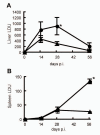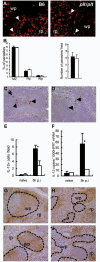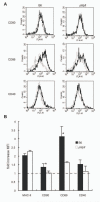Loss of dendritic cell migration and impaired resistance to Leishmania donovani infection in mice deficient in CCL19 and CCL21
- PMID: 16622017
- PMCID: PMC3602896
- DOI: 10.4049/jimmunol.176.9.5486
Loss of dendritic cell migration and impaired resistance to Leishmania donovani infection in mice deficient in CCL19 and CCL21
Abstract
The encounter between APC and T cells is crucial for initiating immune responses to infectious microorganisms. In the spleen, interaction between dendritic cells (DC) and T cells occurs in the periarteriolar lymphoid sheath (PALS) into which DC and T cells migrate from the marginal zone (MZ) along chemokine gradients. However, the importance of DC migration from the MZ into the PALS for immune responses and host resistance to microbial infection has not yet been elucidated. In this study, we report that following Leishmania donovani infection of mice, the migration of splenic DC is regulated by the CCR7 ligands CCL19/CCL21. DC in plt/plt mutant mice that lack these chemokines are less activated and produce less IL-12, compared with those in wild-type mice. Similar findings are seen when mice are treated with pertussis toxin, which blocks chemokine signaling in vivo. plt/plt mice had increased susceptibility to L. donovani infection compared with wild-type mice, as determined by spleen and liver parasite burden. Analysis of splenic cytokine profiles at day 14 postinfection demonstrated that IFN-gamma and IL-4 mRNA accumulation was comparable in wild-type and plt/plt mice. In contrast, accumulation of mRNA for IL-10 was elevated in plt/plt mice. In addition, plt/plt mice mounted a delayed hepatic granulomatous response and fewer effector T cells migrated into the liver. Taken together, we conclude that DC migration from the MZ to the PALS is necessary for full activation of DC and the optimal induction of protective immunity against L. donovani.
Figures







Similar articles
-
Localization of marginal zone macrophages is regulated by C-C chemokine ligands 21/19.J Immunol. 2004 Oct 15;173(8):4815-20. doi: 10.4049/jimmunol.173.8.4815. J Immunol. 2004. PMID: 15470021
-
Defective CCR7 expression on dendritic cells contributes to the development of visceral leishmaniasis.Nat Immunol. 2002 Dec;3(12):1185-91. doi: 10.1038/ni861. Epub 2002 Nov 18. Nat Immunol. 2002. PMID: 12436111
-
CXCL9 antagonism further extends prolonged cardiac allograft survival in CCL19/CCL21-deficient mice.Am J Transplant. 2005 Sep;5(9):2104-13. doi: 10.1111/j.1600-6143.2005.00996.x. Am J Transplant. 2005. PMID: 16095489
-
A myriad of functions and complex regulation of the CCR7/CCL19/CCL21 chemokine axis in the adaptive immune system.Cytokine Growth Factor Rev. 2013 Jun;24(3):269-83. doi: 10.1016/j.cytogfr.2013.03.001. Epub 2013 Apr 12. Cytokine Growth Factor Rev. 2013. PMID: 23587803 Review.
-
Leukocyte migration: scent of the T zone.Curr Biol. 2000 Jan 13;10(1):R30-3. doi: 10.1016/s0960-9822(99)00253-5. Curr Biol. 2000. PMID: 10660291 Review.
Cited by
-
Low CXCL13 expression, splenic lymphoid tissue atrophy and germinal center disruption in severe canine visceral leishmaniasis.PLoS One. 2012;7(1):e29103. doi: 10.1371/journal.pone.0029103. Epub 2012 Jan 5. PLoS One. 2012. PMID: 22242159 Free PMC article.
-
Modulation of Innate Immune Mechanisms to Enhance Leishmania Vaccine-Induced Immunity: Role of Coinhibitory Molecules.Front Immunol. 2016 May 13;7:187. doi: 10.3389/fimmu.2016.00187. eCollection 2016. Front Immunol. 2016. PMID: 27242794 Free PMC article. Review.
-
Potential biomarkers of immune protection in human leishmaniasis.Med Microbiol Immunol. 2021 Jun;210(2-3):81-100. doi: 10.1007/s00430-021-00703-8. Epub 2021 May 2. Med Microbiol Immunol. 2021. PMID: 33934238 Free PMC article. Review.
-
CCL21/CCR7 signaling in macrophages promotes joint inflammation and Th17-mediated osteoclast formation in rheumatoid arthritis.Cell Mol Life Sci. 2020 Apr;77(7):1387-1399. doi: 10.1007/s00018-019-03235-w. Epub 2019 Jul 24. Cell Mol Life Sci. 2020. PMID: 31342120 Free PMC article.
-
Heat-killed Mycobacterium tuberculosis prime-boost vaccination induces myeloid-derived suppressor cells with spleen dendritic cell-killing capability.JCI Insight. 2019 Jun 4;5(13):e128664. doi: 10.1172/jci.insight.128664. JCI Insight. 2019. PMID: 31162143 Free PMC article.
References
-
- Banchereau J, Steinman RM. Dendritic cells and the control of immunity. Nature. 1998;392:245–252. - PubMed
-
- Cyster JG. Leukocyte migration: scent of the T zone. Curr Biol. 2000;10:R30–33. - PubMed
-
- Campbell DJ, Kim CH, Butcher EC. Chemokines in the systemic organization of immunity. Immunol Rev. 2003;195:58–71. - PubMed
Publication types
MeSH terms
Substances
Grants and funding
LinkOut - more resources
Full Text Sources
Medical
Molecular Biology Databases

